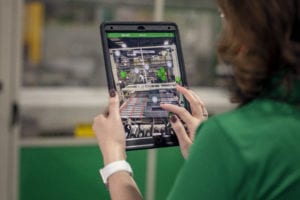In this blog series we will answer a question that we often hear from our customers: what is all the hype about analytics, and how can they help my facility? Specifically, we will be looking at how a rapidly changing world is making it more challenging to maintain operational resilience. We will then see how the newest innovations in power analytics help simplify your job by giving you the answers you need while enabling problem-solving collaboration across your enterprise.
Succeeding in the new electric world: resilience is key
In 2020, our resilience is being tested like never before. The recent pandemic exposed the limits of our healthcare systems while climate change is challenging the resiliency of many systems, one of which is our electrical infrastructure.
These climate impacts are causing stakeholders, from scientists and activists to politicians, to act. Regulations, public awareness, and business goals are fueling the growth of sustainable energy sources, energy storage, and microgrids. Bloomberg NEF estimates that renewable energy will represent 50 percent of generation by 2040.
Along with new energy sources is a corresponding trend toward electrification of commercial and industrial processes resulting in massive growth in electrical loads. This includes a shift in facility heating technologies from fossil fuels to electric with scenarios showing potential for 100 percent of HVAC to be electrified by 2050, a continued increase in robotics of nearly 20 percent by 2025, and a forecast of up to 56% of electrified commercial vehicles by 2040.
The shift to sustainable energy sources combined with the shift to electrified loads is increasing the pressure on facility teams to ensure power resilience.
Analytics is Built on a Digital Foundation
The world is also becoming more digital. By 2025 there will be eight times more connected devices, and as many connected people. The Internet-of-Things (IoT) has permeated everything from vehicles to mobile devices, and with its trajectory of decreasing cost it will soon be part of every aspect of business operations. IoT devices are also getting smarter. Analyst firm IDC predicted that 40 percent of initial IoT data analysis will be at the edge by 2022.
Within this context, Schneider Electric envisions a ‘New Electric World’, in which a growing number of electrified assets are fully digitized and interconnected. For any organization, a digitized electrical infrastructure will act as the foundation for analytics, helping human teams meet the challenge of maintaining resilience, efficiency, and sustainability.
With seamless connectivity across all levels – from electrical assets to ‘edge control’ to the cloud – there is now a greater need for collaboration between facility-based digital teams (IT), electrical (OT) teams, and corporate analytics teams who can turn the data into insights. Working together, these three teams can deliver deeper intelligence to their facility management, finance, and C level stakeholders.
Choosing a Power Analytics Solution
Electrical distribution systems of the past simply did not include enough sensors to monitor the true state of the network. Nor was there the computing power to turn all the data into actionable insights. Today, it is simple and affordable to install IoT-enabled devices (e.g. thermal sensors, electrical meters, circuit breakers) in more places than ever before. You may already have many connected devices in place. If not, older switchgear can be ‘modernized’ with a retrofit solution.
Fed by connected device data, cloud computing is enabling extensive power analytics that deliver new insights that are not possible with human expertise alone. These capabilities are coming at a time when experienced electrical engineers are retiring. As young ‘digital natives’ join the workforce, transfer of knowledge between experts is more difficult due to their different backgrounds and new requirements for working remotely, potentially across time zones.
Power analytics help address this dilemma, allowing deep expertise to be encoded, refined and then leveraged across the enterprise. Analytics augment the capabilities of human teams, helping them handle the increasing complexity of their electrified infrastructure. For this reason, organizations should start today in taking advantage of the latest power analytics solutions.
Here are five key considerations when choosing a solution. We will cover each of these in more detail in future posts.
1. Data quality analytics – confident decisions need trustworthy data. As more IoT devices are connected throughout your electrical infrastructure, they will generate vast amounts of data. Before you can convert that data into insights, you first need to ensure that the data is trustworthy. Incorrect data can result from many issues such as wiring errors during commissioning, configuration changes during maintenance, or unit conversion incompatibility when data is aggregated at the corporate level. Just as you need to build resilience into your electrical network – e.g. cyber security, redundant architectures, etc. – you also need to build resilience into your power data network with the help of data quality analytics. Read our blog, “The Key to Power Analytics You Can Trust: Data Quality.“
2. Deploying analytics at every level – insights for every application. The best power analytic solutions use a distributed approach to deliver timely, actionable information closest to where it is needed. Analytics embedded in devices can identify conditions that need immediate response, with no time for human intervention. At the edge, analytics can simplify the operator experience, enhancing situational awareness. Cloud-based analytics can access corporate and public data, and potentially years of operational data, helping optimize performance and prioritize repair or upgrade investments at a system-wide level. Read our blog, “Three Tiers of Power Analytics: Insights You Need to Ensure Resilience and Efficiency.“
3. The power of the digital twin – from root cause analysis to risk prediction. The data from a digitized electrical network enables accurate modeling of its performance. Often referred to as a ‘digital twin’, the model is used in an analytic platform to enhance resilience in important ways. For example, diagnosing the root cause of a recent event or simulating an outcome before an action is taken, such as whether it is safe to open a breaker. At its most powerful, a digital twin can prescribe best steps moving forward – e.g. optimizing maintenance schedules – as well as predicting equipment wear or the impact of upgrades. Read our blog, “How Power Analytics Can Benefit From Digital Twins.”
4. Enabling remote services with analytics – the resilience multiplier. Cloud-based power analytics are a core enabler of expert services. A variety of power, energy, asset, and safety management services can augment in-house teams in support of greater resiliency, while meeting corporate efficiency goals and compliance with environmental regulations. Here, analytics can enable your remote partner to quickly understand your system context, identify the top priorities, and focus immediately on them with no time lost to re-discovering what internal teams already know. Read our blog, “How Power Analytics Can Enable remote Services.“
5. Analytics as a gateway to deeper collaboration – connecting facility domains and teams. Just as you accrue the benefits of analytics for improving electrical resilience, other teams in your organizations will be using analytics in their own domains – e.g. mechanical (e.g. HVAC) systems, industrial process systems, and security systems. Increasing data sharing and cross-team collaboration can open greater opportunities to optimize infrastructures and processes for efficiency and resilience. Read our blog, “Power Analytics: Taking Insights to the Enterprise Level.”
Learn How EcoStruxture Can Help
The IoT-enabled, future-proof EcoStruxure Power architecture from Schneider Electric supports digitized power distribution, enabling enhanced connectivity, real-time operations, and smart analytics. EcoStruxure Power Advisor is a proactive, analytics-based service for your power management system, delivering optimized performance and power reliability and resilience.



